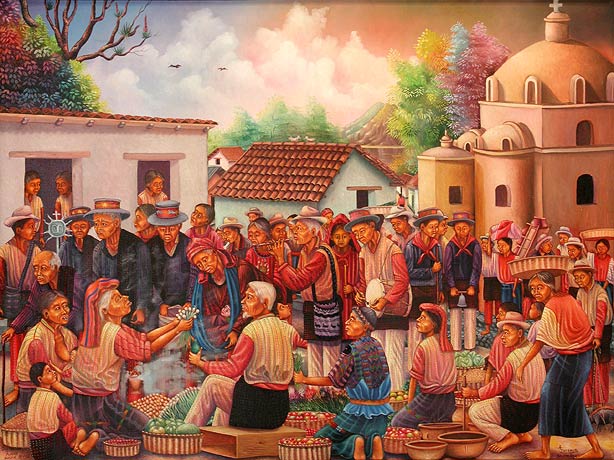

Día de los Reyes, Sololá
(Day of the Three Kings, in the town of Sololá)
1993
28" x 38", oil on canvas
Antonio C. Ixtamer (painter) and Vicente Cumes Pop (theme and supervision)
Bought by Vicente for Arte Maya from Ixtamer
Mayan Catholics celebrate the visit of the three king to Jesus on the 6th of January. This is the third of the themes that Vicente Cumes Pop gave to Ixtamer, and is Ixtamer’s most ambitious painting to date and perhaps his largest. Vicente influenced Ixtamer in the density of the crowd and the quantity of figures in the painting—forty-six figures, not including the doll representing the Christ child. Of the forty six figures the faces of only three are not visible, a common technique used to by some mayan artists not to have to paint so many faces.
In Día de los Reyes Ixtamer limits his color palate to two main colors, red and blue. The composition can be divided horizontally into two almost equal parts—the simpler upper part which contains all the buildings, the trees, the lake and the sky; and the much more complex lower part which contains all the people and the market. This painting was a giant step for Ixtamer. The proportions of the figures in this painting seem more normal, as compared to the previous painting with the figures were elongated. Whereas most of the faces of the people seem rather generic, Ixtamer does a number of portraits in the faces of a three of the seated figures, the onion seller, the woman nursing, and the avocado seller. The figure of the man carrying the baby Jesus, however, has been drawn from a painting by Carmen L. Pettersen which appeared in her book Maya of Guatemala of which Ixtamer was familiar or had a copy. The derivation of this figure caused a big controversy between Vicente and Ixtamer, and it was the last time to our knowledge that Ixtamer drew any of his figures from the paintings of another artist, a practice not uncommon among many of the artists. Since Ixtamer drew this figure from Petterson’s painting I will quote what she says about the event in her book:
"The Streets are jammed on Friday’s market day. It is the sixth of January and the frail old man, head of the Church Confraternity, carries the Christ Child on a special tray slung on a silk Chinese scarf. He is supported on either side by the next two most important men. A third receives donations from the market women who then take a few of the blessed rose petals from the tray and slip them under their blouses. The procession’s way down the cluttered street is opened by twelve men holding symbolic spears. A drummer and a man with the ‘chirimia’ whistle [flute] announce the immediate Presence."
This raises the whole question of copying, a question which is judged by very different standards by peoples of a third world country, than by the art world.